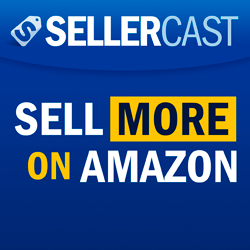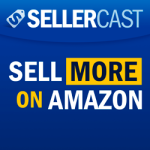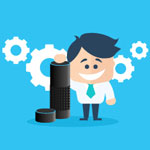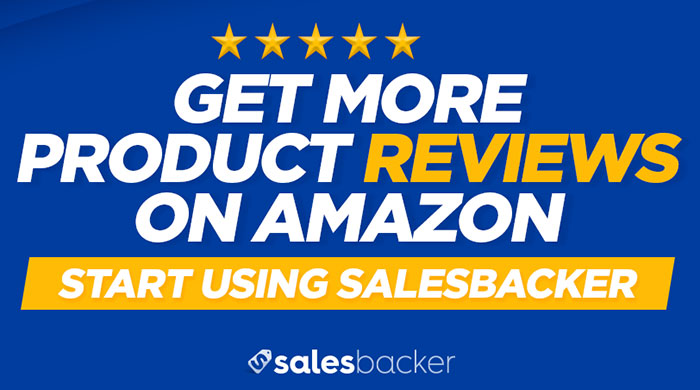 Direct podcast MP3 download link
Direct podcast MP3 download link
Like the show? Get new episodes on iTunes or Stitcher
Rich is a full time practicing doctor and in his spare time slowly building a pet product empire by continuously reinvesting the profits from his business with a goal to be selling 20 products by the end of the year.
In this episode Rich also shares what it's like working with products that have batteries built into them (a first for our show) and also some specific moments of "epic failure" while working to grow this business. I'm sure you'll love what Rich had to share on today's episode.
Need more product reviews?
If you'd like to get more reviews for your products on Amazon check out Salesbacker.
Podcast Transcript
Intro: Hello everyone, Chris Guthrie here, host of Sellercast. And in today’s episode, I speak with Rich, who’s been selling in the pet space since June of 2015. He has six products now, and he’s in the process of getting up to 20 products by the end of the 2016 time frame. So we talk about some of the early success he had in that first product, epic failure in the second product, and then some of the challenges of selling products that use batteries. So that’s the first time we’ve had a guest on here that’s talked about those challenges. So if you’re new and you’re just getting started or thinking about selling a product that has a battery, you’ll like that discussion point as well.
The episode show notes link is Sellercast.com/21 if you want to go there and check out the transcript, links, anything else that’s been mentioned in the show. Let’s start the show.
=====
Chris Guthrie: Hello everyone, Chris Guthrie here. And today I have Rich on the podcast as well. Rich, thank you so much for joining us.
Rich: A pleasure to be here, Chris. Thank you for having me.
Chris Guthrie: Yeah, so I’m excited that you’re here. And I know that you’re a newer seller as well. Let’s start with that. How long have you been selling on Amazon? And when did you get your first sale out there?
Rich: My go-live date was actually June 25th of last year. And I had my first sale the very next day on June 26th.
Chris Guthrie: Awesome. Did you have everything ready with your listing and everything else at the time that you went live? Or is it just one of those natural sales that came in from… just kind of an indicator that you made into a good niche?
Rich: I was pretty surprised about that first sale. I did have everything ready, but I hadn’t launched a promo. But my listing was in place. I had my keyword research done. And I was just really stoked that I had a sale the very next day. And that compelled me to keep moving forward and doing all the other necessary steps.
Chris Guthrie: Cool, and we’ll dive into that. So what were you doing before you started selling on Amazon then, just to give us a bit of your background?
Rich: My day job is I’m a family practice physician and clinical informaticist. And I have a lot of debt. So at the time, I was doing what many people do: affiliate marketing. So I was making niche websites for the Amazon associates program. And I also built some websites with some auto-scripts for eBay commissions. And I really did this to provide myself with some extra income during my medical school training. That’s kind of how it started. It started in the bridal niche, the pet niche, and basically the medical student and physician niches. And I thought I was doing pretty well. I had extra $200 to $500 a month, depending on the season, coming in from those websites. And I think at the maximum, I’d owned 33 domains at the time.
Chris Guthrie: Okay. Are any of those sites still making money? Or have Google updates since wiped them out?
Rich: Yeah, the updates pretty much wiped most of them out. I get a couple of sales here and there.
Chris Guthrie: Yeah. So what made you decide to start selling on Amazon? Were you looking for something more long-term? [laughs]
Rich: I was looking for a way to rescue those sites. And I actually came across your product, AmaSuite, back in January of 2015. I tried to ferret out some more profitable niches that I could make websites for. And you have this training video section on the members’ site. And I was not aware that there was this whole private labeling thing on Amazon. So I basically watched all your training videos. And I ripped the audio on them to MP3 so I could listen to them during my training runs and my daily work commute. And it just really appealed to me.
I mean before I went to med school, I was a salesman. I ran a small company upstart and also as a programmer. The idea of creating a product and selling it on Amazon was extremely appealing to me.
Chris Guthrie: That’s awesome. I think that that’s a good point too. I think that a lot of people that are listening, hopefully, if they are working a day job, maybe they’re already actively selling full-time. But they’re using this time to learn, as opposed to just listening to idiots on the radio. I haven’t listened to the radio in years now. I just listen to podcasts, whenever and wherever possible, to always be learning. But that’s great. So that’s how you got going. That’s awesome.
Are you only focused on private labeling now? Or have you done any other selling on Amazon as well?
Rich: I do not do any retail arbitrage, only private labeling. I looked at retail arbitrage, and it appears like way too much work for me. I like to see my wife getting into it. She loves the shop. So maybe I can get her in on that on the side.
Chris Guthrie: Yeah, I need to get someone that does retail arbitrage onto the show. I haven’t had anyone on yet. So if anyone is listening and they’ve been doing that and they’ve done it successfully, Sellercast.com/21 will be the show notes for this episode. And then you can comment on the show and say, “Hey, I do that, and I do it well,” or something. And we can see about getting you on here.
What are your goals for this business? What are you trying to do with this? Maybe you can talk about where you’re at right now after getting started in June 2015.
Rich: Well, I kind of had not so lofty goals when I started. But I think it’s vitally important to make goals and write them down and work toward them daily. Looking at my notes here, my goal was really to hit $5000 monthly revenue by September of 2015 and then $10,000 monthly revenue by December of 2015. And I knew I was kind of shooting pie in the sky. I knew it was going to be an uphill battle. But then things took off at the end of October. And really December of 2015, this past month, I did $27,000 in revenue.
Chris Guthrie: That’s great. How many products were you selling at the time?
Rich: At the time, I had four SKUs up.
Chris Guthrie: Okay. How quickly did you get your SKUs up? So you had your first sale near the very end of June. And that was probably the first moment like, “Oh sweet, this is working.” And then what did you do next? Did you say, “Okay, how can I get another product up right away?” Is that pretty much what you did? When did you get those other products going?
Rich: Well, I launched the second SKU about a month and a half after the first one. And really, I saw the power of multiplication and really wanted to get more products live as quickly as possible. And that second SKU just did not do well. I made a few mistakes in that regard. And then I added another two doing some additional product research. And as soon as those went live and they took off, I wanted to add more SKUs. Ideally, I’d like to have 20 SKUs live by Christmas this coming year.
Chris Guthrie: Okay, awesome. Let’s get back to your goals for this. And then we’ll talk about some of the mistakes and the process of growing your business.
Rich: Okay, I think it’s good to have personal goals. And I work a lot of hours. I used to work 80-90 hours a week. Thankfully, I don’t do that anymore. I work about 55 hours a week on average now. But I really would like to spend more time with my family. And I’m fascinated by this idea of leaving a family legacy behind for my children’s children. I started this business also to help out my father. He got hosed in a layoffs back in 2000 and basically lost a lot of his retirement. He’s a salesman as well. So I wanted to help him out and bring him into the business as well because this makes sense. I also personally have $400,000 in student loan debt to pay off. So I’m trying to do a debt snowball and increase my cash flow.
I love what I do. I don’t want to quit doing it. But I would love the opportunity to scale back eventually, and I really see this business model was the way to do it.
Chris Guthrie: So were you doing 80-90 just in your practice? Or is that combined? Everything you’re doing on the side, trying to build up Amazon at the same time.
Rich: No, that was when I was in my residency training a few years ago, 30-hour shifts. It’s necessary to get that training, but it is pretty arduous.
Chris Guthrie: Yeah, yeah. I have a few friends that went that path. And no offense, but I’m glad you didn’t go that way [laughs]. Okay, cool. So let’s talk a little bit more about that product selection. So you had that second product. You mentioned that you made a mistake. And you had the first one. You did well. And you thought, “Okay, this is easy. I should get the next one going.” So what were the mistakes that you made with that second product?
Rich: My first product was mediocre at best. My second product was a total epic fail. I didn’t do the due diligence. And I was kind of afraid of competition. To give you some perspective on that, I only sold 500 units of my first product since June. That’s not great, but that’s a benchmark to go for. But my second product, I went for the most premium product you could ever make. I mean I poured $10 a unit into this product and purchased 300 of them. And I shot for a BSR of 2500 to 5000 in my niche. And I’ve sold approximately 75 of those. I still have 225 in stock as of today. So potentially a $2300 mistake. But I have some plans to do some giveaways with the product. At least get some leverage out of them. And I’ve got to do that soon because Amazon has some long-term storage fee penalties. I need to liquidate that inventory as soon as I can.
Chris Guthrie: Are you able to say what niche you’re in, just to provide context for people that are listening?
Rich: I’m in the pet niche.
Chris Guthrie: Okay, so 2500 to 5000 BSR in the pet niche. So the second product… The long-term storage fees — those don’t hit until after the first year, I believe. So you still have some time, I guess, right?
Rich: I have some time, but I need to get those liquidated soon because otherwise, they’ll sit around. I haven’t had a sale on those in two months, believe it or not.
Chris Guthrie: Yeah, okay. So how much time are you typically spending on this? I mean if you’ve got four products up, I’ve got to assume you’ve been spending a decent amount of time to get those going and with a goal of 20 to 25 products by the end of the year.
Rich: Don’t take this the wrong way if you’re listening, but on average, I spend about 10 to 30 minutes a day on this business. There is a lot of upfront work that you have to do. You do a lot of research. For example, today I made a payment to one supplier and worked on a new label for one of my new products. So I put in about 30 minutes today. But on average, just the daily maintenance, following up with customer emails and such, anywhere from 10 to 15 minutes a day is the average once you get up and going.
Chris Guthrie: Okay. So then what are you doing to get that time down so low? Or just the products you are selling don’t require very much customer support? Or do you have some contract labor that’s helping you out in some way?
Rich: Well, first off, I’m selling products with batteries. I do not recommend anything with a battery as one of your first products because the return rate and the failure rate on those run anywhere from 5 to 10 percent on average. We only get about two or three customer emails a day. Sometimes we get none. I’ve brought my father into the business and have farmed out the customer service aspect to him. And he’s off to the races and running that. My idea is eventually, as we grow more and more SKUs, the customer service tasks are going to become more and more onerous. So I have plans to outsource the customer service and the social media advertising aspect to Jamaica or Philippines to a VA.
Chris Guthrie: Okay, and so going back to point about the batteries, I think that out of the people we’ve had on the show who have disclosed their products, you’re the first one who’s mentioned that you’ve been selling something with batteries in it. So can you talk about some of the challenges beyond the failure rate? Why do you think you wouldn’t do that? I know you’re in pets, but if you think about just the general consumer electronics space, for example, there’s just so much volume there. And some people are doing so well with it. Do you think it can be done well? And if it can be, what do you think are some of the things people should keep in mind if they want to sell something that really requires a battery?
Rich: One thing is when you do your calculations in terms of profit projections, you need to be on the safe side and just take 10 percent off the top, just to account for possible returns, defective products and such. The other thing is they do require more effort to airship. If you have something with a lithium battery in it, you have to have the battery contained within the device, and you have to have a special label put on the packaging. So you have to work with your supplier to make sure that they know that because it could get held up in customs and there’s things with with fines.
And also, Amazon has this hazmat process that has taken me anywhere from 3 to 30 days to complete. So you have to figure that into your lead time as well. But with that said, I have friends who have done extremely well with things like USB chargers, battery iPhone cases. There are some electronic products that do really well. And if you have the volume to support it and you’re willing to put up with the extra level of customer service and offer some type of guarantee, I think it’s a viable strategy.
Chris Guthrie: Okay, that’s interesting. So the hazmat thing, the 3 to 30 days, is that something that you have to deal with every time you ship in new goods, correct?
Rich: Correct.
Chris Guthrie: Yeah, okay. I wanted to talk about this briefly too. Because you’ve got products going, what type of system do you have in place to get going so quickly on your products? I know that you’re saying you’re doing about 30 minutes a day right now. But of course when you’re doing a new product, definitely more time that you typically would put in there. Is it just a matter of once you get to a certain point in sales and you’ve made enough money back, then you start to add more products? What’s your system for doing that?
Rich: Well, I’m a big fan of checklists. And the checklists that I have for products, first off is people tend to skip on the product research phase of picking products. And that’s probably the most important phase that I’ve found, now that I’ve done six product launches. So there are many theories on BSR ranges and sales. I know there are products out there like Jungle Scout. I tend to favor more competitive products now since I know there’s a market supported. To the day, I still have not sold a barbecue grill brush or a garlic press yet. But what I do right now is I’m targeting products between a BSR of 300 and 2500. And if you contrast that, the lower sales volume products are nice because of relatively low maintenance in terms of having to keep track of your inventory, and there’s actually less competition. And I found the opposite is true. The lower your average BSR of the product, of course the profit potential is higher. We have more competition, which means you need more reviews. And you have to worry about hijackers and fake negative reviews and things like that.
So the strategy that we use right now, I have AmaSuite. And what I do is I look at a statistical one-week rolling average of BSR on products, just to see what the competitors are selling on average. I think if you take a snapshot, you can fall into the trap of someone is running a coupon deal or a giveaway promo, and it’s artificially elevated. So you can get lulled into a sense that oh wow, this product is doing really well, when in fact, it was doing well for that day that you checked. So very important to do your product research in that regard.
Chris Guthrie: Yeah. And another good site for people that might be aware of it is camelcamelcamel.com. I know that they do tracking of prices, mainly for consumers that are looking to get deals on Amazon. But they happen to store the BSR ranks there as well. And they have usually years of history if the product is something that they’ve been tracking for a while.
Okay, so that’s what you’re doing for the BSR side. What do you think that you’re doing for your launches? You mentioned that you have six products right now. And you’ve had varying success with each one. So I know a little bit about what your second product was and how you struggled with that one at the higher unit cost. But what were you doing to get your sales going for your products? And have you found certain strategies that have worked better and those that haven’t worked as well for you?
Rich: The best way to explain that is look at the evolution of how we launch a product. The first time I launch a product, we were really skittish and decided we just do friends and family for reviews and giveaways to get those initial salvo reviews. I was a very firm believer in getting 30 reviews up immediately, which is what you talked about in your material. So we did friends and family first. And now things have changed. About half of those reviews are gone with Amazon’s new policies. So after that, we would do a 50-unit giveaway. And we would blast out a high-cost Amazon pay-per-click campaign for two weeks. We also did a Facebook sales funnel and a YouTube marketing campaign. And that seemed to work well for the third and the fourth products. And actually, during that time, we were also doing press releases for the launches. But for the third and fourth products, I neglected to do that on my checklist, but found out it really didn’t matter that much.
Chris Guthrie: So for the YouTube marketing, I’d like to talk briefly about that. Were you using some type of a third-party service to do that? Are you launching videos within your own channel and trying to grow your brand that way?
Rich: We were launching them on our own channel and using Google AdWords. Within the AdWords platform, you can actually run a video ad. We went on Fiverr, had a video intro made, and also licensed some heroic-sounding background music, and made our own commercial, and did a 15- to 20-second spot on YouTube and drove traffic that way, and found that it worked fairly well.
Chris Guthrie: Interesting. So you don’t have to share your specific view numbers, but can you give a rough range of how many views you’re getting from that? This is the question: You’re getting views from obviously driving them through paid traffic. But were you getting additional organic views as a result of that? Or maybe you were doing some other marketing efforts to get views to your YouTube channel as well.
Rich: Obviously we have some organic views after that, but at the time we launched, we had 3000 views at a click-through rate of 3.32 percent. And unfortunately, I was not using the Amazon Associates affiliate link to track my conversions, which I’m doing now.
Chris Guthrie: Interesting. So now that you’re doing that, have you seen enough data to really get a sense of how well you’re getting sales from these YouTube channels?
Rich: About break-even at this point, but really, break-even is good because if you want to get your sales velocity up, that’s a good way to do. I see that as an investment, not as just an expense.
Chris Guthrie: I like that. So you’re really using kind of a multi-faceted approach to your product launches now. So you’ve got YouTube channels. You mentioned that you tried press releases, but you don’t do them as often. What were the other two elements that you’re using?
Rich: We’re using Facebook sales funnel, basically an ad campaign that went to a site. And then that site would presell the product. And then they would click through. And that was really just to try to preserve our conversion rate. And Amazon PPC.
Chris Guthrie: Awesome, that’s cool. Is there anything else that I didn’t ask you about from your launching process? Do you want to suggest people that are listening that maybe are starting out, or they’re doing well and they’re just thinking of other ideas they can employ in their business?
Rich: Well, in retrospect, Chris, I would’ve launched more products sooner. I would not have been shy about doing initial giveaway products. I know everyone getting started is really worried about giving away part of their initial order because they want to make money fast. But I remember listening to your tutorial videos. And I guess you had Paul Sinclair on one of them. And I was thinking through things I would’ve done. I think you can’t be hesitant to give products away. It’s an investment. And if you do it in the correct way, and you do it in a way that has multiple sources of traffic, I think the Amazon algorithm rewards you for that.
Chris Guthrie: Yeah, that makes sense. The other thing too is that when you’re thinking about selling something that a lot of people may be selling as well, then it comes down to, yes, product differentiation, but also to how you’re differentiating yourself in the marketing. And that then becomes an almost competitive advantage that other people don’t have. I’m sure that a good chunk of your competitors probably aren’t driving paid traffic to YouTube video ad and then tracking their conversions from Amazon and have Amazon affiliate link in the video ad, or from the YouTube video, rather, and doing some other things too. So that’s great.
Let’s talk a little bit about your sourcing aspect. You’ve been launching pretty quickly. You’re shooting for 20 SKUs by the end of 2016. How are you sourcing your products? And what are you doing to do that? Are you using just one supplier, and they have a bunch of different things that you can source? Or how are you doing that?
Rich: Currently, I have two suppliers. I found the first supplier on Alibaba. And basically, I’ve followed everyone’s advice, and only searching Gold Suppliers. I also clicked the on-site check that I hear that’s not as crucial. But it’s really important to find someone, if you can, that can sell multiple products in your niche that are viable. That was not one of my criteria when I started, but I can see the value in that.
Also, it was really important that I could find someone that could communicate with me in English, because it saves you a lot of time in communication, and someone that’s very responsive to you. So I use an app on my phone called WhatsApp. And that allows me to get around the great firewall of China to some degree [laughs]. So I can send photos and videos to my suppliers. And that helps with the communication aspect as well.
Chris Guthrie: Okay. For the SKUs that you’re trying to launch now, the other ones, are you planning on using those same initial suppliers? Or are you looking at finding more?
Rich: I’m going to use my original supplier for the next SKU that I launch. And then for a new product brand, I’m working with a new supplier that’s actually domestic. Again, I found them mainly through Google search. So you can find suppliers domestically very easily through Google search. But there’s nothing wrong with working through someone in China as long as you find someone that can communicate with you, that you can negotiate with, and someone that you can build a business relationship with.
Chris Guthrie: Yeah, okay. So then are you also doing anything else to control the quality of your products? You mentioned the 5 to 10 percent battery failure rate. I’m assuming that you’re doing something to try and keep that down. Or that’s maybe after the inspection process.
Rich: Let me diverge a little bit on that [laughs]. I have had some quality issues, if you can read between the lines. The first thing is if you’re going to do an initial order, find someone who accepts PayPal or credit card for your first order, so you have that extra layer of protection if something goes wrong, so you can actually dispute. I’ve never used the Alibaba protection or escrow service before. I’ve always just found the contact and dealt with directly. But I do prefer that layer of protection.
Now I will say that on one of my orders, I had 10 percent of my order that went to Amazon was defective. Now the first time I ordered the product, I had it shipped to my house. And that’s a given. That’s on my checklist. Every time I order a product for the first time, it comes to my house first so I can look at the labeling, make sure the ASIN barcode is correct and is scannable, and make sure that when the product gets to Amazon, it’s ready, without any problems, to be sold to consumer. But I’ve gotten to the point now where I literally just phone in the wire and send them the labels and off it goes.
But I had 10 percent of my order that was defective. So in that case, you have a choice. You can either back out your inventory from Amazon, which can potentially be catastrophic to your sales, or what I did is I negotiated a discount on future product orders with the supplier. And they did work to fix the issue. You can also use third-party inspection services. And my advice to everyone out there is if you’re not going to do that initially, I think any order over a thousand units should have a third-party inspection service involved – just to make sure that the goods that you’re purchasing are quality.
Chris Guthrie: I don’t think you did the discount on future orders because I think that if it’s supplied over the course of those future orders, then they’re eventually going to be able to just keep making money at the same time. Whereas if you demand money back, if you’re a newer customer, they might just be like, “Well, we’re not going to work with you anymore.” But that’s good. I’m glad that worked out well for you.
Rich: On that note, I think it’s worth mentioning. It’s very important to develop a relationship with your suppliers. I think if they respect you more and if you add a personal touch, they’re willing to negotiate on prices and fix problems as they come along. It’ll get back to you quicker. I send our supplier pictures of my family and ask how they’re doing and treat him like a human being.
Chris Guthrie: That’s great. I was going to ask you about the personal touch. It sounds like exchanging your family photos and just talking to them more in general about other things beyond just business.
The other question too I had was when you’re building e-commerce businesses, beyond some of the challenges you already described, which are the things that can come up as well, what are some of the other problems you’ve had along the way? What about cash flow issues? What are you trying to do to manage that part of the business?
Rich: I haven’t run into a major problem yet from a business aspect. I have had some delays in the manufacturing of the product. But you had some wise advice a while back on one of your podcasts that said, “The best way to stifle the growth of your business is to take the money out.” So I’ve reinvested every single dime back into the business because I have a secondary source of income, and I’m not relying on this to make ends meet. I have not had a major cash flow issue yet. I’ve done nothing but expansion.
Chris Guthrie: Yeah, that’s interesting. And I think that’s still great advice, especially for people who have a secondary income. If people are trying to do this as a replacement eventually, then it’s tough to just be pumping all the money back in. But at what point are you planning on taking some cash out?
Rich: When we hit the $30k revenue a month two months in a row, we’re going to start taking some small distributions. I’ve talked to my accountant. By the way, if you don’t have an accountant yet, you should totally get one. We’re going to convert to an S corporation and take a small salary.
Chris Guthrie: That’s a great way to do it. I’m almost wondering too, even thing further down the line. I know that your goal is to try to launch the number of SKUs that you’re going after. But are you thinking as well about a potential sale of the business? I mean you mentioned before, $400,000 student loan, which is a lot, I’m sure as you know and feel that burden you talked about as well. Do you feel the call where if you get to that mark, you could sell, and you’d be able to wipe out that student loan? Or are you thinking, “You know what? This is something that I can really scale and grow. And maybe it’s something that I do full-time instead.”
Rich: I am aware of people that flip these businesses. I know that’s a viable model. But I’m in this for the long haul. I think… Well, I don’t want to say I think. I know that I can grow this business to be a million-dollar a month revenue business. I believe in this model that much. And it’s a lot of fun.
Chris Guthrie: That’s great. Okay, so we’re pretty close to the end of our time here. I’m wondering if there’s anything else that I should’ve asked you about various aspects of your business that people that are further along or people that are just getting started would want to know? Is there anything else you can add?
Rich: Well, I would just say do something, anything for your business every single day. Even if it’s only for five minutes, just do something to move forward. Be diligent in your product research. Remember that having a product on Amazon is better than not having a product on Amazon. And you’ll learn a lot from just getting that first product up. I mean I learned a lot. It was like Amazon MBA in a box, basically. But if you’re on the fence about selling on Amazon, doing the private labeling, it’s a fantastic experience, and you can do really well with it.
Chris Guthrie: Awesome, thanks, Rich, so much for coming on and sharing your experience. I think that you had a lot of great points. And it’s nice of you talking about the battery aspect for people that maybe hadn’t been familiar with that. So thank you so much.
Rich: I appreciate you having me, sir.
=====
Outro: All right, that was the episode with Rich. You can check out the show notes by going to Sellercast.com/21. Hopefully you enjoyed what we had to share in terms of the struggles of dealing with products that have batteries in them. So if you’re thinking about selling products that have batteries, this might give you some insight as to whether you should or shouldn’t move forward. And also too, I think that just the discussion about how to use different traffic sources beyond Amazon to help drive and continue to drive the sales to this business was really helpful as well. So thank you so much for tuning in. And we’ll see you in the next episode. If you have any suggestions on ways to improve this show, or if you’d like to be on this show, you can go to Salesbacker.com/contact. And you can send an email. And I make sure that I read every single one of those. So thank you so much for listening, and we’ll see you in the next show.





